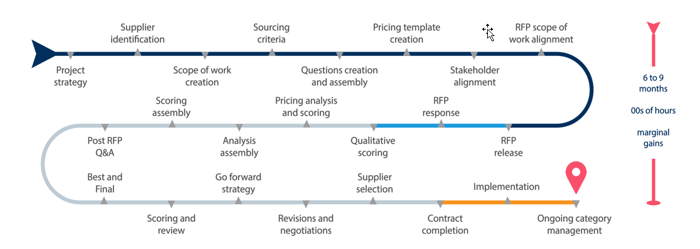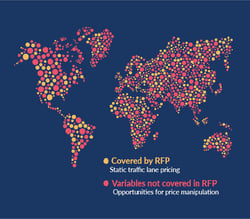Jun 6, 2022 Don’t run a Mobility RFP like it’s 1999
By Kathryn Keho
It’s that time again. You are a corporate mobility professional being asked to make improvements to your mobility supply chain. It might be for your RMC, household goods, temporary housing… Lucky you. But you’re not alone.
Following a very chaotic – and costly – last two years, many companies are being forced to reevaluate their mobility programs. We know that some are doing this the traditional way (by going out to RFP), while others are taking a more targeted approach to evaluating and rebuilding their mobility supply chain. Either way, with household goods moving representing up to 20% of your mobility program’s addressable spend, it is an area worthy of your attention.
You know you need a framework to evaluate, select, and manage your suppliers. But how best to do that with all the uncertainty still at play? Mobility has been undergoing a significant transformation in recent years, bringing changes to your company’s goals and objectives and – most importantly – an increased demand on your time. Corporate mobility is expanding and becoming more strategic, and your responsibilities are fundamentally very different than they were 20+ years ago.
 But the way you’ve done RFPs hasn’t really changed since the days of the cassette tapes and floppy disks. While RFPs have been traditionally designed to create an auditable process that helps companies make decisions, you have bigger goals than creating an auditable decision process. Your goals are to evolve your mobility program to align with your changing HR and talent strategy, create great transferee experiences, and build a sustainable, reliable supplier network.
But the way you’ve done RFPs hasn’t really changed since the days of the cassette tapes and floppy disks. While RFPs have been traditionally designed to create an auditable process that helps companies make decisions, you have bigger goals than creating an auditable decision process. Your goals are to evolve your mobility program to align with your changing HR and talent strategy, create great transferee experiences, and build a sustainable, reliable supplier network.
RFPS are built to deliver static, flat solutions. All of that innovation you and your company are looking for - it’s undermined when much of the focus is looking at the fixed pricing in a cell in a spreadsheet.

When there’s a fixed price on something, but the cost to serve changes, the incentives change. We’re living in times of unprecedented change and uncertainty. Any fixed price today will be less fair tomorrow when costs change for both you and your suppliers. We've never met a single corporate mobility professional who didn’t want their suppliers to be profitable and treated well.
So why are we still buying mobility via RFPs like it’s 1999?
Traditional RFP processes are simply inadequate in meeting the complex demands of today’s corporate mobility programs.
Here’s why the mobility RFP process is broken
-
Mobility RFPs often compare apples 🍎 to oranges 🍊to pineapples 🍍
There’s a high variability in mobility that makes fair comparisons difficult. While bidder’s services, pricing, and KPIs have been commoditized and easy to evaluate, they don't capture the full diversity of the different strengths and service offerings of each potential supplier. -
Mobility RFPs take a significant amount of time and resources
There is a staggering amount of collective time and effort that goes into a major RFP response. For many organizations, the total costs to submit an RFP can easily reach five digits, and well into six digits for the client to evaluate all the information provided. By the time the short list is made, six months or more have passed. Then contracts. Then implementations. There there’s iterations to get to where you actually want the program. These processes can literally take years.

A typical mobility RFP can take 6 to 9 months, thousands of hours, and still only provide marginal gains in performance

-
Global RFPs don't cover the whole picture
An RFP with a global footprint of only 20 locations will require nearly 400 potential traffic lanes, which translates to roughly 20,000 different prices. That's too much data to crunch. Worse, from what we’ve seen, this only covers about half of your eventual future traffic. Think of shipping lanes like the rows and columns on your spreadsheet. They can only work with the data for each lane. They can’t calculate variables or make predictions. So when your RFP asks for pricing between five locations, suppliers only need to provide detailed pricing for those lanes. Any locations not covered in the RFP are significant loopholes for price manipulation.

-
Supplementals are missing from mobility RFPs
Supplementals typically account for 10-20% of the final cost of a move and can cost nearly double the actual cost of that service. But this large part of moving services is rarely accounted for in RFPs, let alone taken into consideration when evaluating relocation costs. Spoiler alert: supplementals are highly vulnerable to price manipulation!
Yikes, that's a lot of challenges for an move pricing expert to overcome, let alone someone who who only thinks about this once every few years! So what's a corporate mobility professional to do about it if they want to improve their household goods supply chain?
First, understand your organization’s mobility goals
Starting your program reevaluation with an end goal in mind may take more time up front, but will ultimately save time in the long run and net you a better result. Your suppliers need to understand where you are today and where you’re going in order to be successful.
Vision, strategy, and communication of your key objectives will help you and your partners identify innovative solutions to meet your challenges. The mobility RFP program is complicated enough without putting the burden on the process of "figuring out what is broken" along the way. If you take the time to outline your organization's specific objectives before you start, then you'll be better equipped to define a process that can best evaluate your suppliers on your most valuable criteria.
Then, design a sustainable sourcing process that works for you
An RFP process cannot encompass all the variable services in the world. When it comes to household goods, trying to lock in rates does more harm than good. Instead, look at innovative mobility sourcing solutions that grow with you as your needs change.
You should establish a baseline benchmark for how your moving program is performing. Look at regional comparisons, shipment modes, supplementals, different policy types, moving methodologies, and service levels appropriate for each transferee persona in your program.
Armed with these insights, you can then implement process changes that will deliver long-lasting value, like:
- Leveraging a data-driven process to identify the right partnerships for you
- Utilizing dynamic pricing so both customers and suppliers are charged and paid appropriately
- Creating incentives that are actionable, where performance is rewarded with your business
- Structuring RFPs to be a starting point for ongoing iteration, rather than systemic changes every three years
Get help from independent move pricing experts
Making these kinds of changes to your sourcing process without the safety net of an RFP may seem daunting. Then again, the process of running an RFP every three years is daunting too.
PricePoint has helped many companies optimize their mobility program supply chain without having to run an RFP. With more than 1000 movers and 1M+ tariffs in our system worldwide, we enable companies to leverage unprecedented industry intelligence - helping them streamline and optimize their mobility programs, save money, and create a move pricing ecosystem built on trust with their suppliers.
We’re hosting a webinar on this very important topic on June 15th, where PricePoint President Ryan Keintz and CEO Ben Heller will join strategic sourcing innovator Vivian Wu to discuss the pitfalls of mobility RFPs and provide solutions to help you Break Free from Mobility RFPs and rethink sourcing, redefine value, and realize savings.
Register to attend or get a recording of the webinar below!
Better still, if you want to share more about your mobility goals and discuss what's possible together, 
As Head of Commercial, Kathryn’s role is to keep PricePoint’s marketing, sales, and revenue operation efforts moving forward. While she’s new to this industry, she brings over 20 years of experience in corporate life sciences. (The jury’s out on whether genome sequencing is more complicated than the 400N). Kathryn is passionate about sharing PricePoint’s vision to make moving and mobility work better for everyone.


